Traveling With Your Dog to the Beach
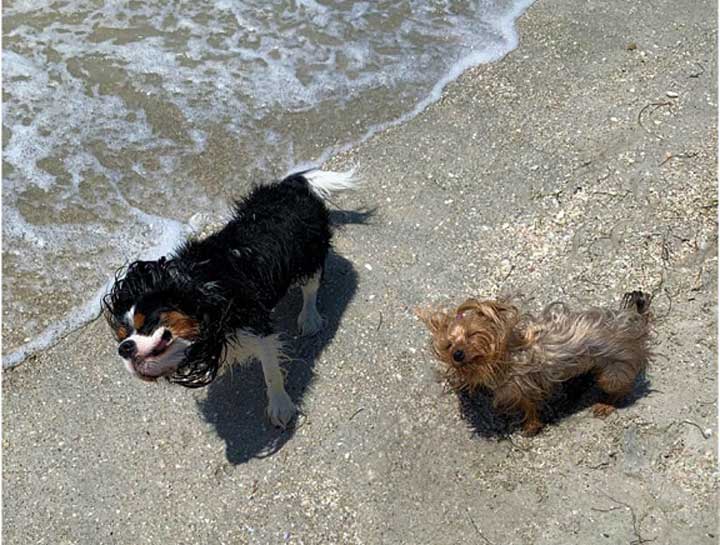
The first destination in our “Traveling with Your Dog to…” blog series was Hillsborough River State Park. For our next installment, we are off to the beach!
There are two dog beaches located in St Petersburg (possibly three if you count Gandy Beach, but we are going to be focusing on Gulf beaches for this blog). Fort De Soto Park was the only choice for many years if you wanted to take your dog to the beach. Around 2016, Pass-a-Grille added a dog beach to their stretch of sand.
Pass-a-Grille
Pass-a-Grille’s beach is a bit more limited than Fort De Soto, not only in size but also in restrictions and parking. The beach is located between First and Third Avenues North on Pass-a-Grille, and parking was reported to be $3.25 per hour on reviews we found.
Also noted in reviews was that parking fills up quickly and that the beach itself is located near a busy road. This was a concern for many who felt like their dog could run out into traffic. But since the dog beach requires that dogs be on a leash no longer than 8 feet in length, the road shouldn’t be an issue for those following the rules.
Other rules include:
- Dogs are not allowed on dunes or other protected areas
- Owners cannot bring rawhide or consumable dog toys or food
- Puppies younger than 4 months old or dogs in heat are not allowed.
Fort De Soto
Because dogs are allowed to be off-leash at Fort De Soto, and due to the beach’s larger size, we chose it for our outing and set off. Fort De Soto is a 1,136-acre county park and has been named not only one of the nation’s best beaches but was picked as one of the Top 10 Dog-Friendly beaches by Petside.com.
Within the park, adjacent to the dog beach, there is a dog park that was named one of the South’s Best Dog Parks by Southern Living Magazine. The dog park, or “Paw Playground,” is divided into little dog and big dog sections, and there are showers and dog-level water fountains to help keep your pup clean and cool. There is a $5 fee to get into the park, but parking is free. Keep in mind there are also tolls along the way to the beach.
There are just three rules posted as you walk to the beach:
- All dogs must be under voice restraint at all times.
- Dog owners are responsible for collecting and removing their dog’s waste.
- Dog owners are responsible for their dog’s behavior at all times.
Just under the sign, there are poop bags provided so that you will have no problem obeying rule number two. Dog poop impacts the environment for fish and wildlife, not to mention that it’s unpleasant to step in, so be sure to clean up after your dog!
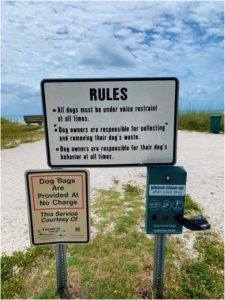
Fort De Soto Park rules for the dog beach.
So Much Water!
This was London’s first trip to the beach and she was SUPER excited to get out there…until she got to the water’s edge. She’s not fond of baths; and this cold, lapping, noisy wet stuff was completely new to her.
This brings us to one of the most important parts of visiting a beach, lake, river, pool, or any other large body of water: Don’t assume that your dog automatically knows how to swim, or even likes being in the water for that matter. Allow your dog to take it at their own pace and never force them to go in the water.
London was eventually okay getting her paws wet, and then by the time we were getting ready to leave, she was following us into the water until she was about chest deep. For 5-pound London, this was barely ankle-deep water for us! It was a major accomplishment for her though.
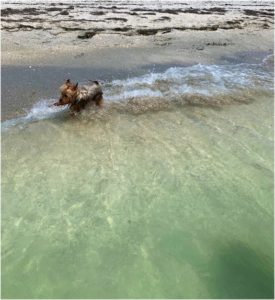
London plays it up at her first visit to Fort De Soto Dog Beach!
When your dog is exploring the water, one of the first things they’re tempted to do is drink it. This is NOT good for them. Even a little salt water can induce vomiting, and if all the water doesn’t come back out, it will act as a laxative and cause diarrhea.
Further warning: Ingesting large amounts of salt water, especially in combination with dehydration from the activity and a hot day can result in potentially fatal electrolyte imbalances, which can cause swelling of the brain leading to incoordination, seizures, and death. Make sure you offer your dog plenty of fresh, cool drinking water—the Florida sun can quickly take a toll, especially when your dog is running and playing with other dogs.
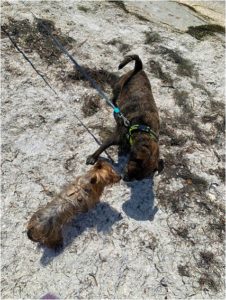
Yogi and London getting acquainted.
London has rarely met another dog or human she doesn’t want to be instant best friends with. So she was happy to run along meeting and greeting others as she went. Everyone seemed to be in a really good mood and was a good sport when London would run up to say hello.
All in all, it was a really enjoyable day for everyone, and we had one exhausted pup who happily slept for the rest of the day. Here are some things to keep in mind when planning your dog’s trip to the beach:
Pre-Planning
- Make sure your dog is up-to-date on their vaccines to avoid the potential of contracting a communicable disease from another dog.
- Pack plenty of drinking water along with a bowl, towels, something to provide shade, dog-safe sunscreen, a dog life vest if needed, waterproof toys, and poop bags. A first aid kit is handy too.
- Don’t forget the money for tolls, park entry fees, and parking.
When you’re arriving and departing from the beach, keep in mind the pavement can be really hot! Consider carrying small dogs or having large dogs wear heat-protecting socks.
Once you’re at the beach, be sure to set up a spot where your dog can retreat for some shade. Most people had umbrellas or sun tents set up, and their dogs were taking advantage of this when they weren’t in the water or romping with other dogs.
.jpg)
Be prepared to get wet, even if you aren’t going in the water. We got showered by lots of dogs shaking the water from their coats—London and her new friend Lenny perfected their synchronized shaking.
Other Safety Precautions
We also saw dogs wearing life vests, which are an excellent idea for small dogs and those with short legs and/or short muzzles. These dogs tire especially quickly and are aided by extra buoyancy. Even if your dog is an excellent swimmer, you never know when choppy water or a strong undercurrent can prove to be too much for them.
Dogs can sunburn just like humans, especially on the areas of skin with not much fur, like the tops of their noses, ears, and anywhere the hair parts and reveals skin. Also just like us, dogs are at risk for skin cancer, so applying a dog-safe sunscreen to any areas where you can see the skin is important. Reapply after swimming.
Overheating can affect any dog, especially ones that have thick coats and those that have short muzzles. Watch for signs of heat exhaustion in dogs, which include:
- Excessive or rapid panting and drooling
- Vomiting
- Diarrhea
- Lethargy
- Disorientation or coordination issues
- Collapse
- Loss of consciousness
Too often, once you see these signs, your dog is already in acute distress. Don’t delay in getting your dog cooled down and call your vet for further instructions. Planning a trip to the beach in the morning or after 4pm can help you avoid the harshest of the sun’s rays, and temperatures will be a little cooler too.
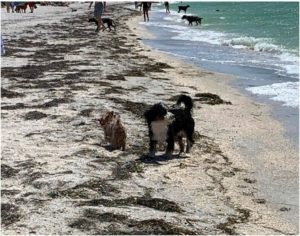
Plenty of opportunities to make new man’s best friends!
Keep an eye out for anything that can cause injury or illness. We saw a dead fish that dogs can be keen to investigate, but there can also be jellyfish, broken glass, fish hooks, sharp coral, or other items that can pose a hazard. Teaching your dog the “leave it” command is especially beneficial at the beach.
Sand spurs are abundant at Fort De Soto, and can be found in grassy areas and the sand leading up to them. Sand spurs are aptly named as they are sharp, spiky spheres of pain. Once they latch on to fur, they are tricky to remove. These are especially painful if they lodge in your dog’s paw pads. London had one on her side that we found while petting her. It was probably more painful for the person removing it than it was for London! Don’t allow your dog to go into the dune area where most sand spurs grow.
All the dogs that were off-leash at the beach were well-behaved, and the ones that wanted to lunge at other dogs were responsibly kept on a leash by their owners. However, that may not always be the case. If your dog has aggressive tendencies or doesn’t care to share their toys with others, an off-leash dog beach may not be best for them. Always make sure you keep an eye on your dog and that they can be recalled by voice command.
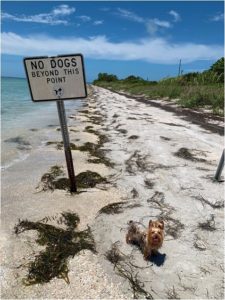
London being a very good girl and obeying the rules. Signs are posted at each end of the dog beach.
End of the Day
Salt water left on your dog’s coat can cause skin irritation, so a rinse with fresh water before you leave the beach can help. A bath when you arrive home will thoroughly remove all salt and sand from your dog’s skin and coat. What better end to a perfect day at the beach than a clean, happy, tuckered-out pup?
If you’ve read the first blog in this series and want to visit a state park, you can combine these two excursions and visit Honeymoon Island, State Park. Located about 40 minutes northwest of St. Petersburg, Honeymoon Island has a designated dog beach area, and dogs are allowed anywhere in the park as well. Dogs must be on a leash no longer than six feet at all times, even on the beach. It’s open from 8am to sundown, every day of the year.
Does your dog enjoy the beach? We’d love to see pictures! Be sure to share them on our Facebook page!
